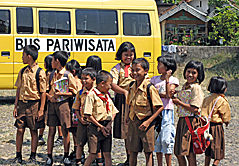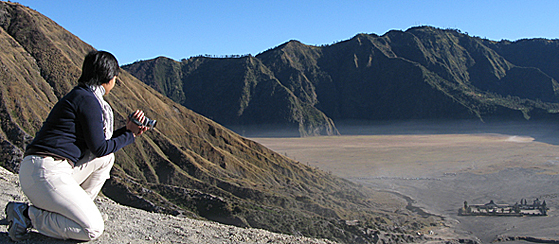By way of Jakarta, the capital of Indonesia, we ended up in Jogjakarta, the cultural capital – according to themselves anyway. Certainly they drive quite a bit more civilized than in North Sumatra, and Jogjakarta does excel within the arts, crafts and education. There are several universities for Protestants, Catholics, Hindus and Muslims, respectively.
Real palaces
The sultan palaces are more like palaces here, especially the Ngayogyakarta Hadiningrat in Kraton – a large complex finished in 1790. It still houses the Sultan and is very yin/yang in design. It has a building for the daughters and one for the sons. As the present Sultan doesn’t have any sons this part of the complex was partially open for visitors. We sat through a couple of musical pieces performed by the Sultan's own jambalan (orchestra) – almost symphonic in nature and very beautiful and pleasing to the ear.
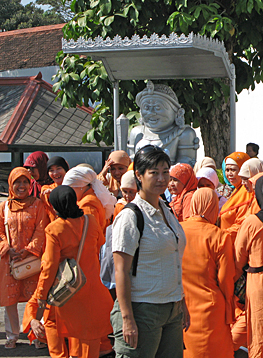
Equally impressive are some of the silver works made here in Jogja. Although most of it would probably look silly on the mantelpiece at home it is very difficult not to admire the attention to detail and the imaginative shapes and sizes of their works. Most of what you may encounter in f.inst. Bali has most likely been designed or produced in Java.
The life and times of Buddha
One of the must-sees around Jogja is no doubt the imposing Buddhist temple complex of Borobudur at Lapangan Banteng. Although it is one of Indonesia's top tourist attractions we didn't find the place crammed at all. The temple has been dated to approx. 830 a.d. and was built using lava stones. The complex contains more than 500 Buddha statues and several thousand well preserved and beautiful bas-reliefs. These reliefs describe the way to the 7th Heaven – Nirvana, and is today a Unesco world heritage site detailing the life and times of Buddha.
We stayed at the site to watch the sun go down and then headed back to Jogja. It seems the power plants don't have the capacity to supply all of Jogja at any one time, so they have come up with a plan to blackout different districts on different nights.
The Great Trinity
On our way East from Jogjakarta to the Tengger Highlands we stopped by another site not to be missed: Prambanan, one of Southeast Asia's largest Hindu shrine temple complexes.
Dedicated to Trimurt or the Great Trinity, i.e. Brahmā the creator, Vishnu the maintainer and Śhiva the destroyer it originally covered a vast expanse with a thousand shrines, large and small. Today the eight shrines in the central compound are most noteworthy with the 47 m tall Śhiva shrine at its centre.
Prambanan took a hit in the 2006 earthquake that also set off the volcano Mt. Merapi. Due to the building technique with each stone being placed loosely on top of the other the shrines were easy targets. Luckily only a small portion of the complex is out of order so to speak and restoration is ongoing.
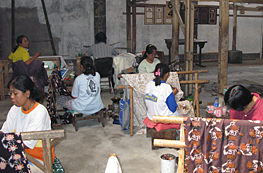
Java at a glance
Once Java was covered in a luxurious blanket of tropical forest moulded by volcanic eruptions across the island. Although Java only constitutes some seven percent of the total land mass, it holds more than 60 percent of Indonesia’s entire population and it’s the most densely populated island in the world. The tropical forests have given way to rice fields and plantations interspersed by no less than 30 volcanoes – many still very much active.
The 2006 earthquake did a lot of damage. When we came closer to the highlands in the Southeast some bare open spaces told the tale of a village having been levelled by mudslides and many roads had been destroyed – the remaining ones were filled to the brim with traffic.
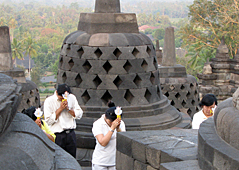
All that glitters
Some of the villages we passed through were decidedly Muslim but migrants from the island of Madura north of Surabaya just looooves all that glitters and put their happy mark on village life. We were told that the Maduras would happily spend their last rupiah on a tattoo or a golden earring instead of food for the family.
The last of our drive ended in hairpin bends and steep climbs 2,000 m asl at the Bromo Cottage 13 hours after leaving Jogjakarta. After a small meal we hit the sack to get as much sleep as possible before our next adventure.
Bright and early
Well, perhaps not so bright as early: Up at zero-three-hundred – temperature a measly 17oC but no winds. We were allocated a Jeep with a local driver and headed up to Pandujakan: A sunrise viewpoint on the rim of the enormous caldera of the Bromo-Tengger-Semeru National Park.
Suddenly the place was
crammed with tourist from the entire area – all with the same purpose, and
most of them better prepared for the ordeal than we were. It seemed that
everybody but us had thick jackets, hats, gloves and scarves. But of course
it was possible to rent jackets and blankets and buy tea and noodle soup and
offerings for the volcanoes at stalls set up by locals.
With the sun slowly rising we got a magnificent view of the caldera, of the
constant oozing of Mt. Bromo and of Mt. Mahameru (3,677 m asl) in the
distance now and again coughing quite a decent puff of smoke into the
atmosphere. This is indeed the land of fire – a great experience.
Horses galore
Afterwards we drove down to the bottom of the crater – down to the sand sea.
Why we had to go in 4x4 Jeeps became quite clear: Crazy inclines everywhere
though the narrow roads were paved with decent asphalt. Nothing grows here
but there is a fine powdery layer of lava sand that easily swirls up. You
could either walk the distance to the foot of Mt. Bromo or – like we and
many others did – rent a horse.

Mine was small, light and cute but Lene chose a bigger one for herself. The
owner walked alongside holding the reigns.
Apparently Lene’s horse handler
thought she looked confident enough so he gave her the reigns. Lene believed
this meant that she was free to take off, and after a slow trot she quickly
coerced her horse into a gallop. The owner kept up with them formidably but
had to let go in the end. My horsie found the behind of another horse and
together we slowly but surely found the foot of the volcano.
At the top of Mt. Bromo
254 steps with appropriately dispersed resting places had been made to
facilitate the climb but the thin air at 2,400 m asl quickly made us gasp.
When we finally reached the top we found that we could walk along the rim of
the crater and look right down into the belly of the beast. Here big steam
clouds constantly oozed out.
Although Mt. Mahameru (also known as Semeru) looked as though it lay
just over the next top it was actually more than 15 km away which was a
great relief as it is still one of the most active volcanoes on Java. But
what a view.
On our way back across the sand sea Lene again took off in a gallop. For a
brief shocking instance my horse started trotting but fortunately the owner
could remote control his horse by whistling and smacking his lips. Great fun.
Safely back at Bromo Cottage we had a hearty breakfast and soon left for
Surabaya.
